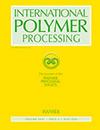纤维直径对短竹纤维增强聚酯复合材料机械性能和吸水性能的影响
IF 1.1
4区 工程技术
Q4 ENGINEERING, CHEMICAL
引用次数: 0
摘要
本研究旨在探讨纤维直径对短竹纤维增强聚酯复合材料机械性能和吸水性能的影响。研究采用三种不同尺寸的纤维(180-250 微米、250-500 微米和 700-1000 微米)制备复合材料,纤维含量分别为 10%、20% 和 30%。制成的复合材料被切割成标准尺寸,并进行了拉伸试验、冲击试验和吸水试验。获得的结果具有可重复性,表明与使用大直径纤维(700-1000 微米)的复合材料相比,使用小直径纤维(180-250 微米)的复合材料的拉伸强度提高了 20%,而拉伸模量则随着纤维直径的减小而提高了 22%。通过对断裂表面的扫描电镜分析发现,纤维直径较大的复合材料表现出更多缺陷(空洞和基质脱落)。与使用最小纤维直径增强的复合材料相比,直径为 700-1000 微米的复合材料的冲击强度提高了 33%。通过在水中长期浸泡,还对复合材料的吸水性进行了研究,结果表明,最初的吸水率很高,在一定时间间隔后达到饱和点。吸水值表明,纤维直径最小(180-250 微米)的复合材料吸水量最大,这是因为产生了更多的吸水点(增加了界面面积),而纤维直径最大(700-1000 微米)的复合材料吸水量最小,这是因为纤维与基体之间的相互作用区域缩小了。本文章由计算机程序翻译,如有差异,请以英文原文为准。
Impact of fiber diameter on mechanical and water absorption properties of short bamboo fiber-reinforced polyester composites
This study aims to investigate the effect of fiber diameter on the mechanical and water absorption characteristics of short bamboo fiber-reinforced polyester composites. Three different fiber sizes (180–250 µm, 250–500 µm, and 700–1000 µm) were used to prepare composites with varying fiber loadings of 10 wt.%, 20 wt.%, and 30 wt.%. The fabricated composites were cut to standard dimensions, and tension tests, impact tests, and water absorption tests were performed. Reproducible results were obtained, revealing that using fibers of smaller diameter (180–250 µm) increased the tensile strength of the composite by 20 % compared to composites with larger diameter fibers (700–1000 µm), while the tensile modulus showed a 22 % enhancement with decreasing fiber diameter. Composites with larger diameter fibers exhibited more defects (voids and matrix detachment), as revealed by SEM analysis of fractured surfaces. The impact strength of composites with a diameter size of 700–1000 µm increased by 33 % compared to composites reinforced with the smallest fiber diameter. Water absorption of the composites was also studied by long-term immersion in water, showing that water intake was high initially, reaching a saturation point after a certain time interval. The absorbed water values indicated that composites with the smallest diameter (180–250 µm) showed maximum water intake due to the creation of more water intake sites (increased interfacial area), while composites with the largest diameter fibers (700–1000 µm) exhibited the least water absorption as the interaction region between fibers and matrix was reduced.
求助全文
通过发布文献求助,成功后即可免费获取论文全文。
去求助
来源期刊

International Polymer Processing
工程技术-高分子科学
CiteScore
2.20
自引率
7.70%
发文量
62
审稿时长
6 months
期刊介绍:
International Polymer Processing offers original research contributions, invited review papers and recent technological developments in processing thermoplastics, thermosets, elastomers and fibers as well as polymer reaction engineering. For more than 25 years International Polymer Processing, the journal of the Polymer Processing Society, provides strictly peer-reviewed, high-quality articles and rapid communications from the leading experts around the world.
 求助内容:
求助内容: 应助结果提醒方式:
应助结果提醒方式:


